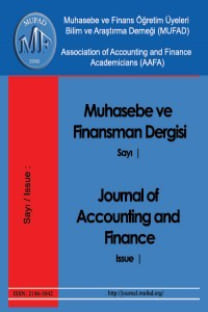Yalın yönetim felsefesinin önemli bir boyutu olarak muhasebede yalınlaşma düşüncesi ve bir yalın muhasebeuygulaması örneği: Kendine faturalama
Bu makale, üretim işletmelerinde yalın yönetim ve üretim anlayışının bir boyutu olarak ortaya çıkan yalınmuhasebe , diğer bir anlatımla muhasebedeki yalınlaşma düşüncesini incelemektedir. Yalın muhasebe, kısaca muhasebesistemlerinin yalın yönetim ve üretim felsefesiyle bütünleşmesi, bu anlayışa katkı sağlayacak, hizmet edecek şekildetasarlanması anlamına gelmektedir. Yalın muhasebenin en önemli amacı, yönetim performansını ve etkinliğini arttırmak,verimliliği ve kaliteyi yükseltmek, değer yaratmak ve memnuniyet sağlamak adına yalınlaşmaktır. Geleneksel muhasebesistemlerinin ürettiği veri yığınları, evrak denizleri ve bilgi dağlarının aksine, iş ve işlem yapmayı hızlandıran, karar vermeyikolaylaştıran, ihmalleri ve hataları önleyen, süreleri kısaltan, süreçleri basitleştiren uygulama ve yöntemleri araştırmak vebenimsemektir. Yalın yönetim ve üretim felsefesini bu anlayışa uygun bir yapı içinde üreteceği yalın ve kaliteli bilgiler iledesteklemektir. Yalın ve kaliteliden kasıt doğru ve güvenilir, gerekli ve geçerli bilgilerin gereksindiği anda, en yüksekyararlılık formunda, en hızlı ancak en az maliyetli biçimde üretilmiş olmasıdır. Bu bağlamda, Tersine (Kendine)Faturalama sistemi muhasebede yalınlaşma düşüncesinin bir ürünü olarak ortaya çıktığından bu çalışmada da incelemekonusu yapılmış ve uygulaması ayrıntılı olarak anlatılmıştır. Zira bu sistemle mevcut iş yükünün yaklaşık %95 oranındaazaldığı, zamandan ve mekândan dolayısıyla maliyetlerden tasarruf edildiği, yönetim ve kontrolün kolaylaştığıgözlemlenebilmektedir.
Lean thinking ın accounting and an implementation example of lean accounting as an ımportant dimension of lean philosopy: Self billing
The purpose of this article is to analyze lean accounting methodology as a consequence of lean accountancy idea,which is the dimension of lean management and manufacturing approach within production entities. In short, meaning oflean accounting is to design all accounting systems in a company, in order to contribute and serve for the integration of leanmanagement idea with production philosophy. Ultimate goal of lean accounting is to implement leaner processes, in order toincrease management performance and efficiency, improve productivity and production quality, so to create value addedfinally for customer satisfaction. On contrary to the large data pools, high number of documentation and informationmountains created as the consequence of traditional accounting systems, it aims to search and adopt for those applications &techniques, which simplifies company accounting procedures and management decision taking, accelerates operations inorder to shorten lead times and avoids human mistakes and negligence in the process. It is to support lean management &production philosophy with lean and high quality information shaped under a lean business environment. Basic intentionbehind saying lean and high quality is to highlight the necessity of producing most accurate, reliable and up-to-dateinformation in an organization with low cost and in a most efficient format. Within this context, as one of the methods(products) of lean accounting approach (idea), Self billing system has been chosen as the subject of this study and itspractices explained in details. Cos by utilizing the self billing system, it is possible to achieve almost 95% less workload(process time) and lower data storage area requirements, which at the end reduces company costs & simplifies managementand controls over the processes.
___
- Balcı, B. R. (2011). Yalın Muhasebe, DEÜ SBE Dergisi, Cilt 13, Sayı 1, ss 39-51.
- Brosnahan Jan P.(2008), Unleash the power of Lean Accounting, Journal of Accountancy, Temmuz 2008, ss 22-25.
- Dolcemascolo, D. (2006). Improving the Extended Value Stream: Lean for the Entire Supply Chain, Productivity Press., New York, ss 34-56
- Durden, C. H.- Hassel L. G.- Upton, D. R.(1999), Cost Accounting and Performance Measurement in a Just in Time Production Environment, Asia Pasific Journal of Management, Sayı 16, No 1, ss.111-125
- Kanun metni, 213 sayılı Vergi Usul Kanunu (2012)
- Maskell, B. H. Ve Baggaley, B. (2009), Lean Management Accounting, http://www.maskell.com/leanAcctg.htm , (10.02.2012)
- Maskell, B. H. (2009). What is Lean Accounting?, http://www.superfactory.com/articles/, (20.02.2012)
- Maskell, Brian H.(2011), What is Lean Accounting?, www.maskell.com/leanacctg.htm, (20.02.2012)
- Maskell, Brian H.- Baggaley, Bruce (2004), Practical Lean Accounting: A Proven System for Measuring and Managing the Lean Enterprise, Productivity Pres. Mynard Rose (2008), Lean Accounting, http://findarticles.com/p/articles/mi_m0JQT/is_2008_March, (25.02.2012)
- Solomon, J. M. (2003), Whos counting?: A Lean Accounting Business Novel, USA: WCM Associations.
- Stenzel, Joe (2007), Lean Accounting Best Practices for Sustainable Integration, John Wiley&Sons, New Jersey.
- Van Der Merwe Anton ve Thomson Jeffrey (2007), The lowndown on Lean Accounting, Strategic Finance, Şubat 2007.
- Yalın Muhasebe, http:// yalinmuhasebe.wordpress.com (11.12.2011)
- ISSN: 2146-3042
- Yayın Aralığı: 4
- Başlangıç: 2005
- Yayıncı: Muhasebe ve Finansman Öğretim Üyeleri Derneği (MUFAD)
